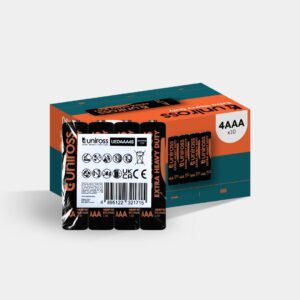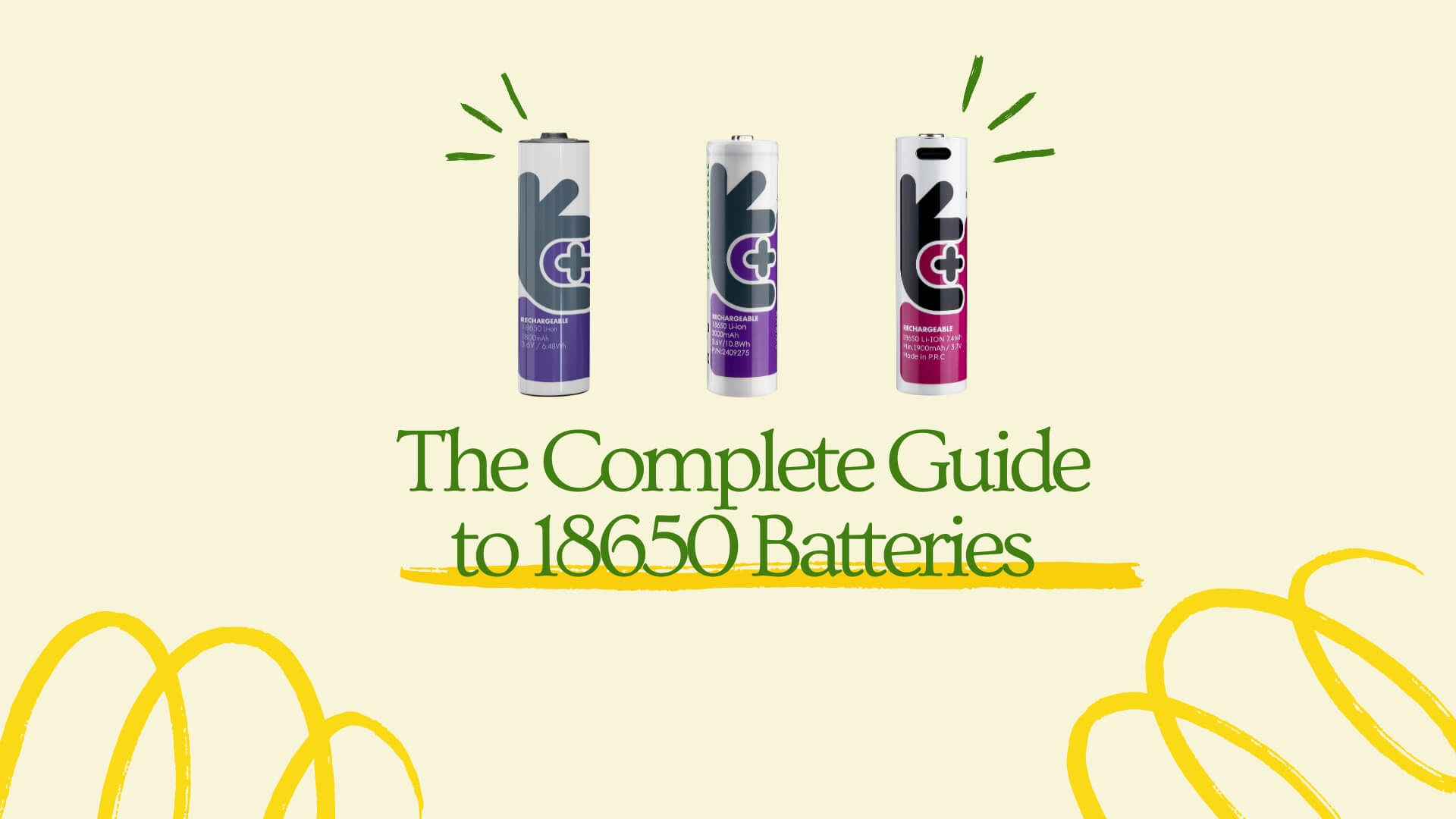AAA batteries are among the most widely used power sources in the world, powering an array of common household and industrial devices. Compact yet powerful, these small cylindrical batteries have become indispensable for electronics such as TV remotes, digital cameras, and clocks, among many others.
What is an AAA Battery?
The AAA battery, sometimes referred to as a “triple-A cell,” provides a reliable source of energy for both low-drain and high-drain devices, depending on the type and chemistry of the battery. Measuring just 44.5mm in length and 10.5mm in diameter, its size and versatility have made it a preferred choice for portable electronics.
What is the Capacity and Voltage of an AAA Battery?
AAA batteries typically operate with a nominal voltage of 1.5V in disposable formats, such as alkaline and carbon-zinc types. On the other hand, rechargeable AAA batteries have varying voltage ranges depending on their chemistry: NiMH batteries generally have a voltage of 1.2V, while Lithium-ion rechargeable cells (commonly referred to as 10440 batteries) boast a higher voltage of 3.7V.
Key characteristics of a AAA battery include:
- Size: 44.5mm length x 10.5mm diameter.
- Nominal voltage: Varying by chemistry — usually 1.5V for disposable and 1.2-3.7V for rechargeables.
- Capacity: Measured in milliamp-hours (mAh), determining how long it can deliver energy.
Types of AAA Batteries
Primary (Disposable) Batteries:
These are designed for single use and disposed of once depleted. Popular primary battery types include:
Alkaline Batteries:
- Best for: Clocks, TV remotes, and flashlights.
- Why Choose Them? Affordable, widely available, and offer a longer shelf life (up to 10 years).
- Considerations: Suitable for low to medium-drain devices; not rechargeable.
Lithium (Non-Rechargeable) Batteries:
- Best for: High-drain or long-term use devices like digital cameras or medical equipment.
- Why Choose Them? Long-lasting with excellent performance in extreme temperatures.
- Considerations: Higher upfront cost compared to alkaline batteries.
Carbon-Zinc Batteries:
- Best for: Low-drain devices like wall clocks or simple toys.
- Why Choose Them? Low cost and good for infrequent use.
- Considerations: Short lifespan compared to alkaline or lithium batteries.
Recommended products
Secondary (Rechargeable) Batteries:
Rechargeable options are growing in popularity for their long-term cost-effectiveness and reduced environmental impact. Key types include:
Nickel Metal Hydride (NiMH):
- Best for: Gaming controllers, flash units, and wireless devices.
- Why Choose Them? Reusable for up to 1000 charge cycles, low self-discharge (especially newer models), and environmentally friendly.
- Considerations: Requires a compatible charger; lower voltage (1.2V) compared to disposable batteries.
Lithium-ion:
- Best for: High-drain gadgets like cameras or specialized equipment.
- Why Choose Them? Lightweight and energy-dense.
- Considerations: Incompatible with 1.5V devices; needs a dedicated charger.
Nickel-Zinc (NiZn):
- Best for: High-performance applications needing brighter lighting or consistent power output.
- Why Choose Them? Higher voltage (1.65V).
Recommended products
How to Choose the Right AAA Battery?
Consider Your Device’s Power Needs:
- Low-drain devices (e.g., remotes, clocks): Alkaline or carbon-zinc batteries are sufficient.
- High-drain devices (e.g., cameras, gaming controllers): Opt for lithium or rechargeable NiMH batteries.
Longevity vs. Cost:
- For devices used infrequently, disposable alkaline batteries may be more economical.
- For high-usage gadgets, rechargeable batteries offer better value in the long term.
Environmental Impact:
- Switch to rechargeable batteries for an eco-friendlier option.
- Always recycle used batteries to minimize environmental harm.
Which AAA Batteries Last the Longest?
When it comes to runtime and lifespan, the longevity of AAA batteries depends on their chemistry and the device they’re powering:
Lithium AAA Batteries:
Provide the longest shelf life (up to 15 years) and best performance in high-drain devices. Perfect for equipment like digital cameras.
Alkaline AAA Batteries:
Optimal for low-drain devices like remotes, clocks, and flashlights. Their shelf life averages 5–10 years.
NiMH Rechargeable Batteries:
Designed for frequent use, they can be recharged up to 1000 times and are excellent for high-drain devices.
Applications of AAA Batteries
AAA batteries power a vast range of devices across household, professional, and industrial use. Their compact size and sufficient voltage make them a staple in powering small electronics. Here are some common and specialized applications:
Everyday Household Devices
- Remote Controls: For TVs, sound systems, and other appliances.
- Clocks: A reliable power source for wall and desk clocks.
- Portable Gaming Accessories: Handheld gaming systems or controllers.
- Personal Care Devices: Grooming gadgets like shavers or trimmers.
- Flashlights: Ideal for compact torches and emergency lighting.
Specialized Applications
- Digital Cameras: High-performance AAA batteries, especially lithium or NiMH, are preferred.
- Healthcare Devices: Blood pressure monitors, pulse oximeters, and hearing amplification devices.
- Smart Devices: Compact sensors and wireless gadgets used in home automation systems.
Professional and Industrial Uses
- Scientific Tools: Laser pointers, multimeters, or measurement devices.
- Emergency Tools: Medical supplies or safety equipment requiring reliable backup power, such as rescue beacons.
- Motorized Toys and Models: Powering small robotic kits, remote control cars, or drones.
By understanding the energy requirements of your device, you can determine whether to opt for standard alkaline AAA batteries for simplicity, lithium batteries for high-drain devices, or rechargeables for frequent use.
Common Questions About AAA Batteries
Battery shopping can be confusing. Below, we’ve answered some of the most common questions to help you make the right decision:
How do I select the right AAA battery?
- Consider the power consumption of your device: Low-drain devices work well with alkaline batteries, while high-drain devices require lithium or NiMH rechargeable batteries.
- Evaluate how often you use the device: Frequent use benefits from rechargeable batteries, while occasional-use devices work best with disposable options.
- Opt for trusted brands like Uniross to ensure performance and safety.
Which type of AAA battery lasts the longest?
Lithium AAA batteries last the longest for high-energy devices and offer the best shelf life (up to 15 years).
Rechargeable NiMH batteries provide significant longevity for frequent use when cycled properly.
Does the type of AAA battery matter?
Yes, matching the battery chemistry and voltage to your device is critical to ensure that the device operates efficiently and without damage. For example:
Use alkaline batteries for low-drain gadgets like remotes.
Choose rechargeable NiMH batteries for energy-draining devices like gaming controllers.
How many volts should a good AAA battery have?
Disposable AAA batteries have a nominal voltage of 1.5 volts.
Rechargeable NiMH AAA batteries typically offer 1.2 volts, while lithium-ion models can deliver up to 3.7 volts depending on the device requirements.
Storage, Maintenance, and Safe Disposal of AAA Batteries
Storage Tips for Extended Battery Life
- Cool, Dry Place: Store batteries in a location with low humidity and moderate temperatures. High heat can lead to leakage or chemical degradation.
- Keep Partially Charged: Rechargeable batteries, like NiMH, maintain their performance better when stored partially charged.
- Avoid Mixing Batteries: Mixing old and new batteries in a device can cause leakage or damage.
Battery Maintenance Tips
- Remove Batteries from Idle Devices: Even when not in use, some devices draw small amounts of power, causing batteries to drain faster.
- Check for Corrosion: Inspect terminals regularly, especially on devices not used often, and clean off any visible buildup.
- Use Quality Chargers: For rechargeable AAA batteries, invest in a smart charger that prevents overcharging and optimizes battery health.
Proper Disposal and Recycling Practices
Disposal of AAA batteries depends on their type:
- Alkaline Batteries: Safe for general trash disposal in some areas but recycling is encouraged wherever facilities exist.
- Rechargeable Batteries: Never dispose of in regular trash. Take them to designated battery recycling facilities due to their chemical components.
- Manufacturer Programs: Some companies offer takeback programs to ensure proper recycling and disposal.
Whether you’re opting for the longevity of lithium-disposable batteries, the cost-effectiveness of rechargeables, or the simplicity of alkaline options, matching the right battery to your device ensures the best results. And don’t forget — recycle used batteries to protect the environment and preserve resources for the future.











